Decathlon Industry Analysis Factsheet and Environmental Business Audit
VerifiedAdded on 2023/06/17
|14
|4371
|420
Report
AI Summary
This report provides a comprehensive industry analysis and environmental business audit, focusing on Decathlon as a case study. The analysis covers different types of organizations, their legal structures, sizes, and scopes, including private, public, and voluntary sectors. It explores the relationship between organizational functions like production, human resources, advertising, and finance, and their linkage with the organizational structure, particularly Decathlon's divisional structure. Furthermore, the report identifies the positive and negative impacts of macro-environmental factors on business operations and conducts internal and external analysis to identify strengths and weaknesses. The interrelation of these strengths and weaknesses with external macro factors is also explained, providing a holistic view of Decathlon's business environment.
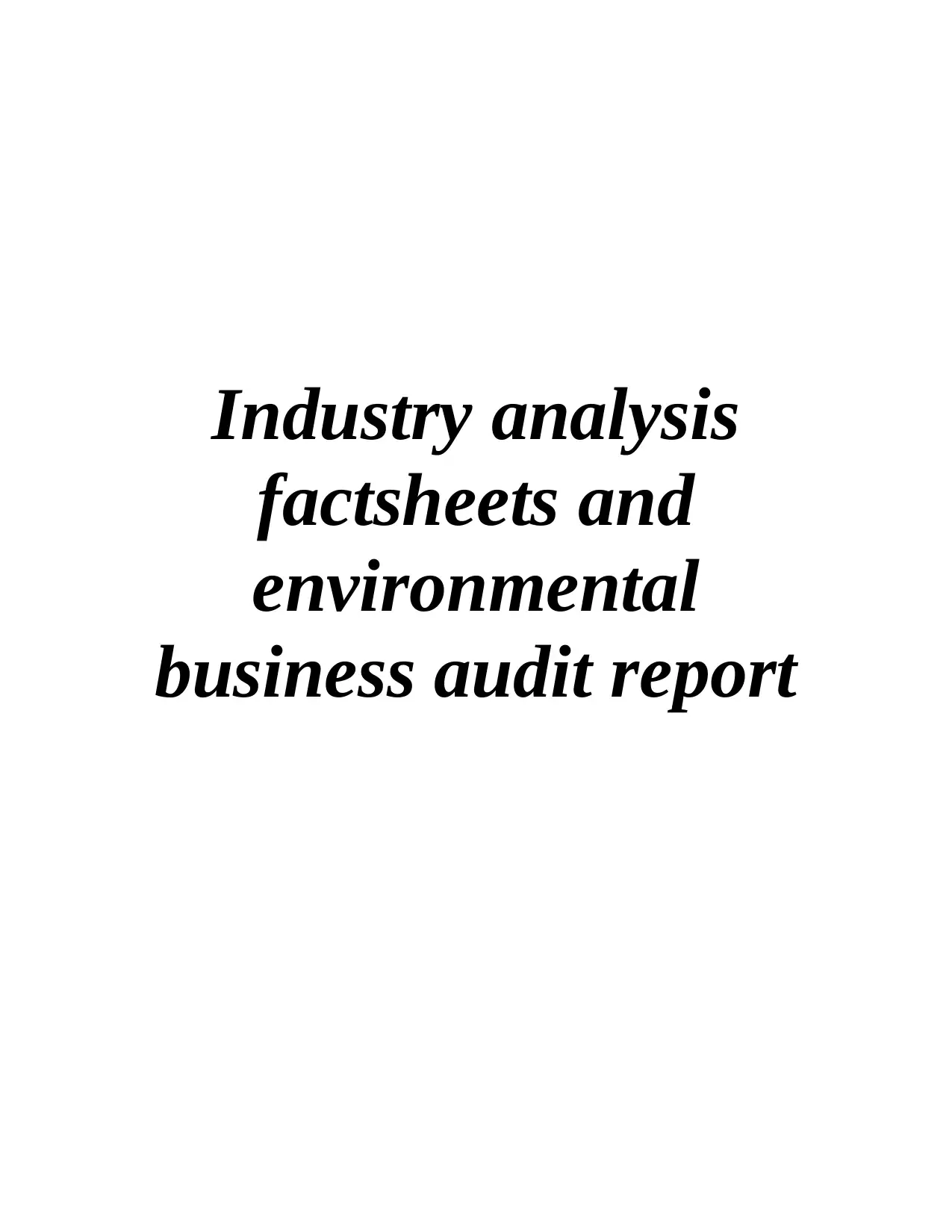
Industry analysis
factsheets and
environmental
business audit report
factsheets and
environmental
business audit report
Paraphrase This Document
Need a fresh take? Get an instant paraphrase of this document with our AI Paraphraser
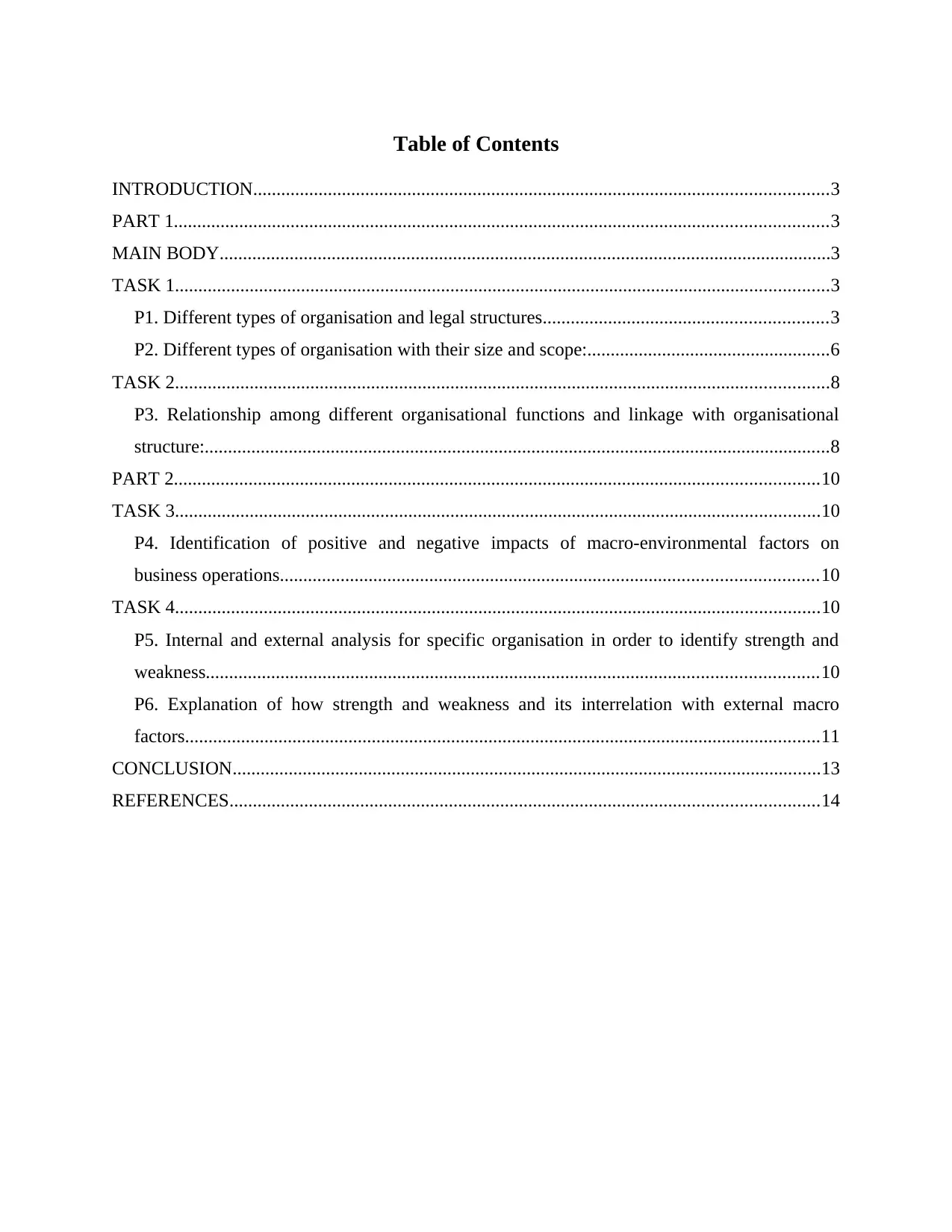
Table of Contents
INTRODUCTION...........................................................................................................................3
PART 1............................................................................................................................................3
MAIN BODY...................................................................................................................................3
TASK 1............................................................................................................................................3
P1. Different types of organisation and legal structures.............................................................3
P2. Different types of organisation with their size and scope:....................................................6
TASK 2............................................................................................................................................8
P3. Relationship among different organisational functions and linkage with organisational
structure:......................................................................................................................................8
PART 2..........................................................................................................................................10
TASK 3..........................................................................................................................................10
P4. Identification of positive and negative impacts of macro-environmental factors on
business operations...................................................................................................................10
TASK 4..........................................................................................................................................10
P5. Internal and external analysis for specific organisation in order to identify strength and
weakness...................................................................................................................................10
P6. Explanation of how strength and weakness and its interrelation with external macro
factors........................................................................................................................................11
CONCLUSION..............................................................................................................................13
REFERENCES..............................................................................................................................14
INTRODUCTION...........................................................................................................................3
PART 1............................................................................................................................................3
MAIN BODY...................................................................................................................................3
TASK 1............................................................................................................................................3
P1. Different types of organisation and legal structures.............................................................3
P2. Different types of organisation with their size and scope:....................................................6
TASK 2............................................................................................................................................8
P3. Relationship among different organisational functions and linkage with organisational
structure:......................................................................................................................................8
PART 2..........................................................................................................................................10
TASK 3..........................................................................................................................................10
P4. Identification of positive and negative impacts of macro-environmental factors on
business operations...................................................................................................................10
TASK 4..........................................................................................................................................10
P5. Internal and external analysis for specific organisation in order to identify strength and
weakness...................................................................................................................................10
P6. Explanation of how strength and weakness and its interrelation with external macro
factors........................................................................................................................................11
CONCLUSION..............................................................................................................................13
REFERENCES..............................................................................................................................14
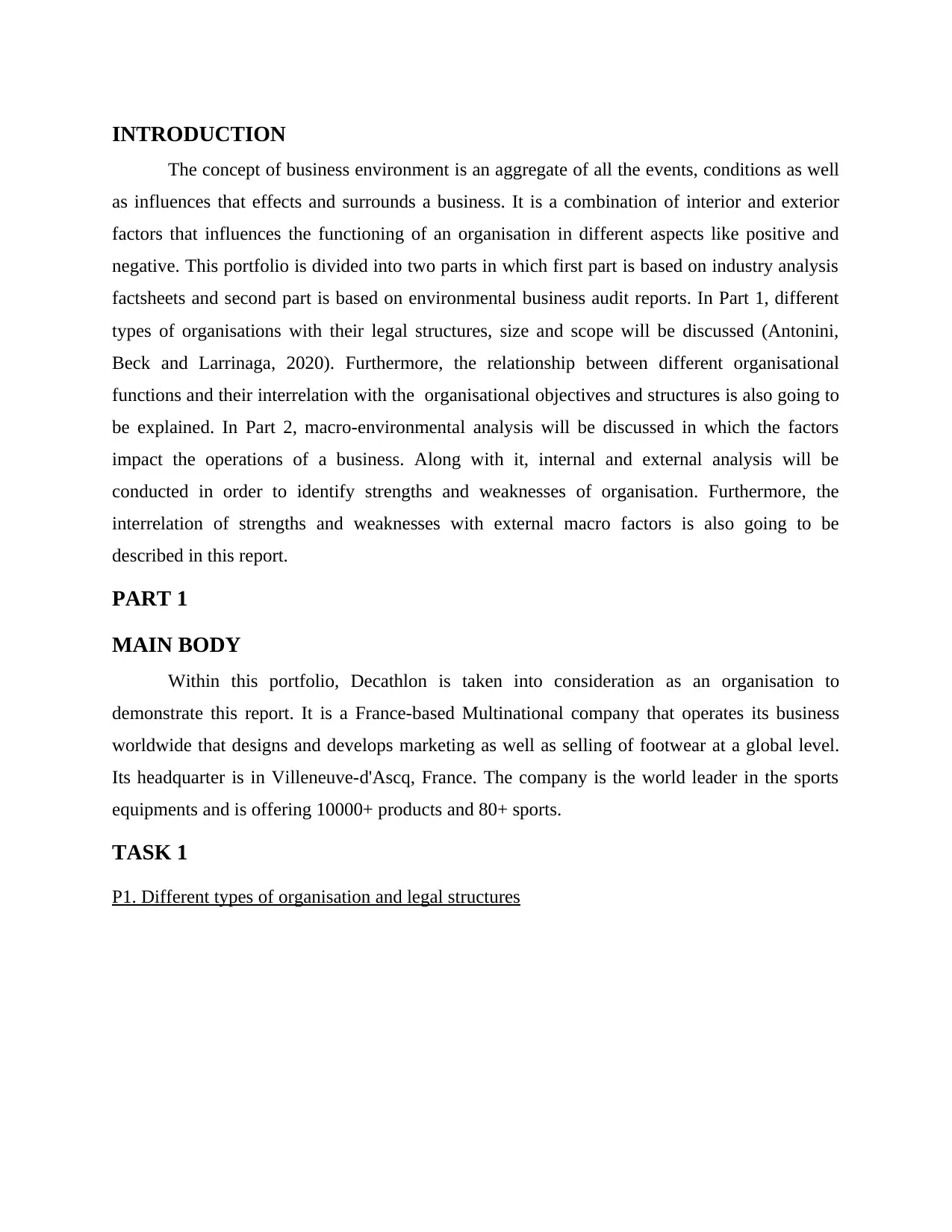
INTRODUCTION
The concept of business environment is an aggregate of all the events, conditions as well
as influences that effects and surrounds a business. It is a combination of interior and exterior
factors that influences the functioning of an organisation in different aspects like positive and
negative. This portfolio is divided into two parts in which first part is based on industry analysis
factsheets and second part is based on environmental business audit reports. In Part 1, different
types of organisations with their legal structures, size and scope will be discussed (Antonini,
Beck and Larrinaga, 2020). Furthermore, the relationship between different organisational
functions and their interrelation with the organisational objectives and structures is also going to
be explained. In Part 2, macro-environmental analysis will be discussed in which the factors
impact the operations of a business. Along with it, internal and external analysis will be
conducted in order to identify strengths and weaknesses of organisation. Furthermore, the
interrelation of strengths and weaknesses with external macro factors is also going to be
described in this report.
PART 1
MAIN BODY
Within this portfolio, Decathlon is taken into consideration as an organisation to
demonstrate this report. It is a France-based Multinational company that operates its business
worldwide that designs and develops marketing as well as selling of footwear at a global level.
Its headquarter is in Villeneuve-d'Ascq, France. The company is the world leader in the sports
equipments and is offering 10000+ products and 80+ sports.
TASK 1
P1. Different types of organisation and legal structures
The concept of business environment is an aggregate of all the events, conditions as well
as influences that effects and surrounds a business. It is a combination of interior and exterior
factors that influences the functioning of an organisation in different aspects like positive and
negative. This portfolio is divided into two parts in which first part is based on industry analysis
factsheets and second part is based on environmental business audit reports. In Part 1, different
types of organisations with their legal structures, size and scope will be discussed (Antonini,
Beck and Larrinaga, 2020). Furthermore, the relationship between different organisational
functions and their interrelation with the organisational objectives and structures is also going to
be explained. In Part 2, macro-environmental analysis will be discussed in which the factors
impact the operations of a business. Along with it, internal and external analysis will be
conducted in order to identify strengths and weaknesses of organisation. Furthermore, the
interrelation of strengths and weaknesses with external macro factors is also going to be
described in this report.
PART 1
MAIN BODY
Within this portfolio, Decathlon is taken into consideration as an organisation to
demonstrate this report. It is a France-based Multinational company that operates its business
worldwide that designs and develops marketing as well as selling of footwear at a global level.
Its headquarter is in Villeneuve-d'Ascq, France. The company is the world leader in the sports
equipments and is offering 10000+ products and 80+ sports.
TASK 1
P1. Different types of organisation and legal structures
⊘ This is a preview!⊘
Do you want full access?
Subscribe today to unlock all pages.

Trusted by 1+ million students worldwide
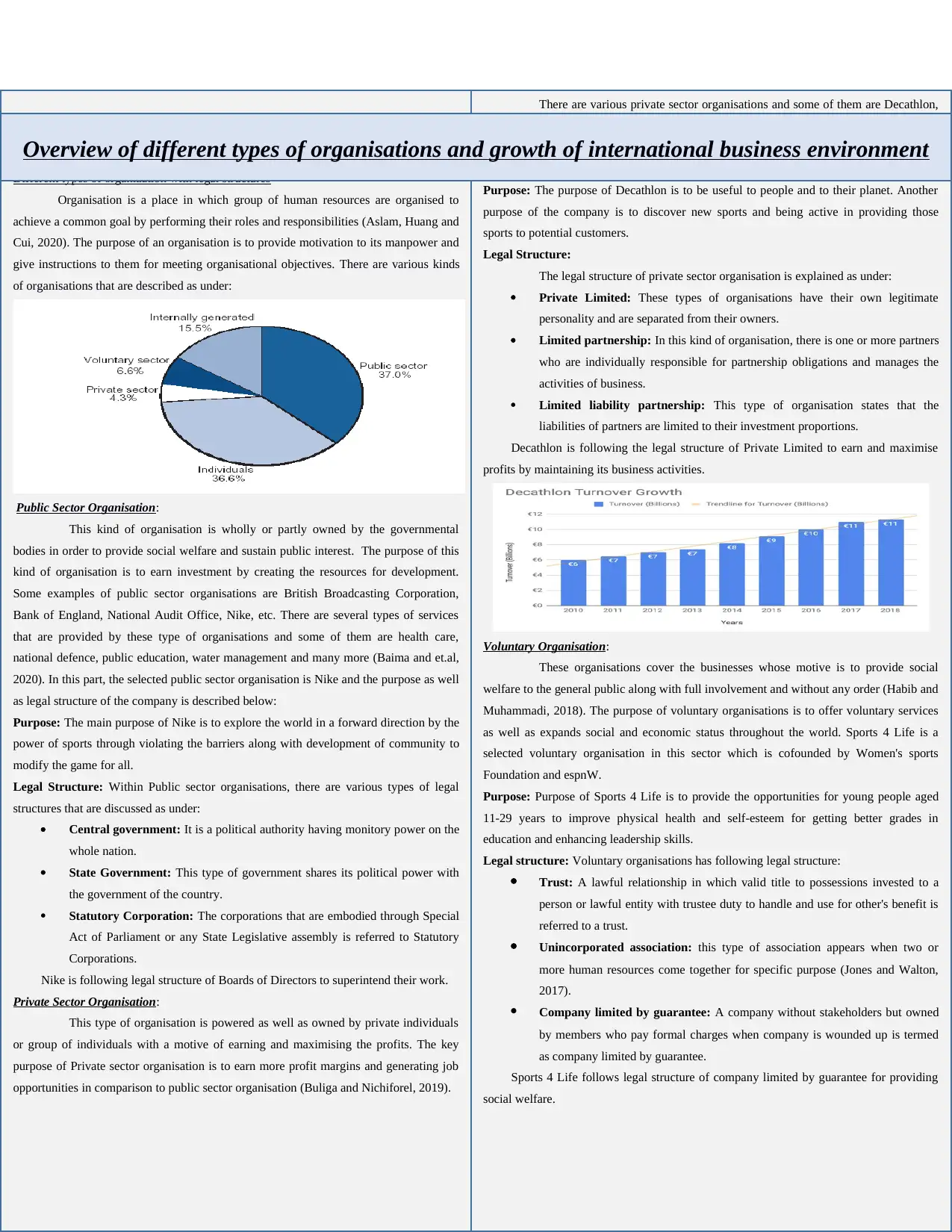
Introduction to sub-sectors and the different types of organisation in the industry,
the market size and the growth of the international business environment
Different types of organization with legal structures
Organisation is a place in which group of human resources are organised to
achieve a common goal by performing their roles and responsibilities (Aslam, Huang and
Cui, 2020). The purpose of an organisation is to provide motivation to its manpower and
give instructions to them for meeting organisational objectives. There are various kinds
of organisations that are described as under:
Public Sector Organisation:
This kind of organisation is wholly or partly owned by the governmental
bodies in order to provide social welfare and sustain public interest. The purpose of this
kind of organisation is to earn investment by creating the resources for development.
Some examples of public sector organisations are British Broadcasting Corporation,
Bank of England, National Audit Office, Nike, etc. There are several types of services
that are provided by these type of organisations and some of them are health care,
national defence, public education, water management and many more (Baima and et.al,
2020). In this part, the selected public sector organisation is Nike and the purpose as well
as legal structure of the company is described below:
Purpose: The main purpose of Nike is to explore the world in a forward direction by the
power of sports through violating the barriers along with development of community to
modify the game for all.
Legal Structure: Within Public sector organisations, there are various types of legal
structures that are discussed as under:
Central government: It is a political authority having monitory power on the
whole nation.
State Government: This type of government shares its political power with
the government of the country.
Statutory Corporation: The corporations that are embodied through Special
Act of Parliament or any State Legislative assembly is referred to Statutory
Corporations.
Nike is following legal structure of Boards of Directors to superintend their work.
Private Sector Organisation:
This type of organisation is powered as well as owned by private individuals
or group of individuals with a motive of earning and maximising the profits. The key
purpose of Private sector organisation is to earn more profit margins and generating job
opportunities in comparison to public sector organisation (Buliga and Nichiforel, 2019).
There are various private sector organisations and some of them are Decathlon,
Puma, Bestway Group, etc. Among the following companies, the chosen Private sector
organisation is Decathlon which is a France-based company and is providing services of
clothing, sportswear, sports equipment and many more.
Purpose: The purpose of Decathlon is to be useful to people and to their planet. Another
purpose of the company is to discover new sports and being active in providing those
sports to potential customers.
Legal Structure:
The legal structure of private sector organisation is explained as under:
Private Limited: These types of organisations have their own legitimate
personality and are separated from their owners.
Limited partnership: In this kind of organisation, there is one or more partners
who are individually responsible for partnership obligations and manages the
activities of business.
Limited liability partnership: This type of organisation states that the
liabilities of partners are limited to their investment proportions.
Decathlon is following the legal structure of Private Limited to earn and maximise
profits by maintaining its business activities.
Voluntary Organisation:
These organisations cover the businesses whose motive is to provide social
welfare to the general public along with full involvement and without any order (Habib and
Muhammadi, 2018). The purpose of voluntary organisations is to offer voluntary services
as well as expands social and economic status throughout the world. Sports 4 Life is a
selected voluntary organisation in this sector which is cofounded by Women's sports
Foundation and espnW.
Purpose: Purpose of Sports 4 Life is to provide the opportunities for young people aged
11-29 years to improve physical health and self-esteem for getting better grades in
education and enhancing leadership skills.
Legal structure: Voluntary organisations has following legal structure:
Trust: A lawful relationship in which valid title to possessions invested to a
person or lawful entity with trustee duty to handle and use for other's benefit is
referred to a trust.
Unincorporated association: this type of association appears when two or
more human resources come together for specific purpose (Jones and Walton,
2017).
Company limited by guarantee: A company without stakeholders but owned
by members who pay formal charges when company is wounded up is termed
as company limited by guarantee.
Sports 4 Life follows legal structure of company limited by guarantee for providing
social welfare.
Overview of different types of organisations and growth of international business environment
the market size and the growth of the international business environment
Different types of organization with legal structures
Organisation is a place in which group of human resources are organised to
achieve a common goal by performing their roles and responsibilities (Aslam, Huang and
Cui, 2020). The purpose of an organisation is to provide motivation to its manpower and
give instructions to them for meeting organisational objectives. There are various kinds
of organisations that are described as under:
Public Sector Organisation:
This kind of organisation is wholly or partly owned by the governmental
bodies in order to provide social welfare and sustain public interest. The purpose of this
kind of organisation is to earn investment by creating the resources for development.
Some examples of public sector organisations are British Broadcasting Corporation,
Bank of England, National Audit Office, Nike, etc. There are several types of services
that are provided by these type of organisations and some of them are health care,
national defence, public education, water management and many more (Baima and et.al,
2020). In this part, the selected public sector organisation is Nike and the purpose as well
as legal structure of the company is described below:
Purpose: The main purpose of Nike is to explore the world in a forward direction by the
power of sports through violating the barriers along with development of community to
modify the game for all.
Legal Structure: Within Public sector organisations, there are various types of legal
structures that are discussed as under:
Central government: It is a political authority having monitory power on the
whole nation.
State Government: This type of government shares its political power with
the government of the country.
Statutory Corporation: The corporations that are embodied through Special
Act of Parliament or any State Legislative assembly is referred to Statutory
Corporations.
Nike is following legal structure of Boards of Directors to superintend their work.
Private Sector Organisation:
This type of organisation is powered as well as owned by private individuals
or group of individuals with a motive of earning and maximising the profits. The key
purpose of Private sector organisation is to earn more profit margins and generating job
opportunities in comparison to public sector organisation (Buliga and Nichiforel, 2019).
There are various private sector organisations and some of them are Decathlon,
Puma, Bestway Group, etc. Among the following companies, the chosen Private sector
organisation is Decathlon which is a France-based company and is providing services of
clothing, sportswear, sports equipment and many more.
Purpose: The purpose of Decathlon is to be useful to people and to their planet. Another
purpose of the company is to discover new sports and being active in providing those
sports to potential customers.
Legal Structure:
The legal structure of private sector organisation is explained as under:
Private Limited: These types of organisations have their own legitimate
personality and are separated from their owners.
Limited partnership: In this kind of organisation, there is one or more partners
who are individually responsible for partnership obligations and manages the
activities of business.
Limited liability partnership: This type of organisation states that the
liabilities of partners are limited to their investment proportions.
Decathlon is following the legal structure of Private Limited to earn and maximise
profits by maintaining its business activities.
Voluntary Organisation:
These organisations cover the businesses whose motive is to provide social
welfare to the general public along with full involvement and without any order (Habib and
Muhammadi, 2018). The purpose of voluntary organisations is to offer voluntary services
as well as expands social and economic status throughout the world. Sports 4 Life is a
selected voluntary organisation in this sector which is cofounded by Women's sports
Foundation and espnW.
Purpose: Purpose of Sports 4 Life is to provide the opportunities for young people aged
11-29 years to improve physical health and self-esteem for getting better grades in
education and enhancing leadership skills.
Legal structure: Voluntary organisations has following legal structure:
Trust: A lawful relationship in which valid title to possessions invested to a
person or lawful entity with trustee duty to handle and use for other's benefit is
referred to a trust.
Unincorporated association: this type of association appears when two or
more human resources come together for specific purpose (Jones and Walton,
2017).
Company limited by guarantee: A company without stakeholders but owned
by members who pay formal charges when company is wounded up is termed
as company limited by guarantee.
Sports 4 Life follows legal structure of company limited by guarantee for providing
social welfare.
Overview of different types of organisations and growth of international business environment
Paraphrase This Document
Need a fresh take? Get an instant paraphrase of this document with our AI Paraphraser
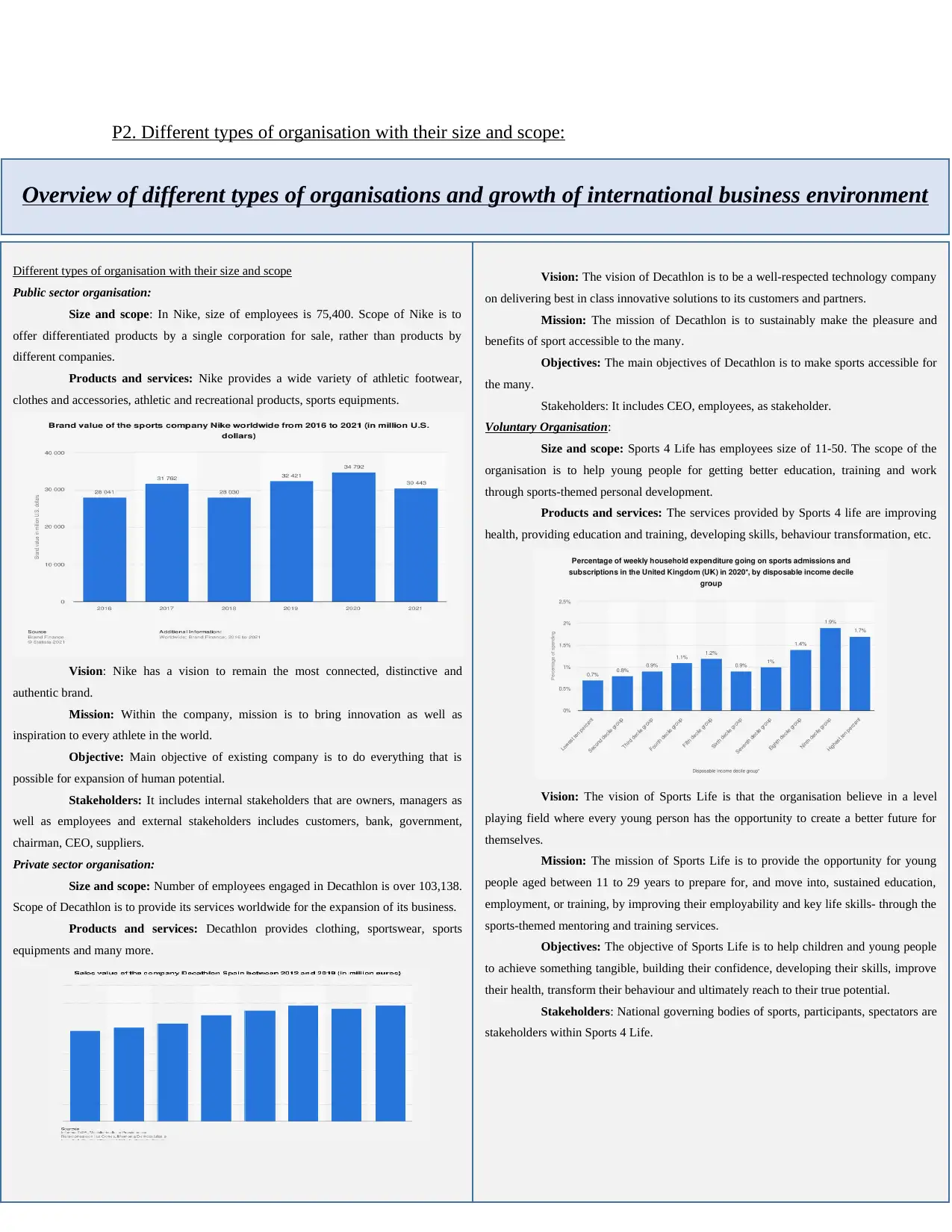
P2. Different types of organisation with their size and scope:
Different types of organisation with their size and scope
Public sector organisation:
Size and scope: In Nike, size of employees is 75,400. Scope of Nike is to
offer differentiated products by a single corporation for sale, rather than products by
different companies.
Products and services: Nike provides a wide variety of athletic footwear,
clothes and accessories, athletic and recreational products, sports equipments.
Vision: Nike has a vision to remain the most connected, distinctive and
authentic brand.
Mission: Within the company, mission is to bring innovation as well as
inspiration to every athlete in the world.
Objective: Main objective of existing company is to do everything that is
possible for expansion of human potential.
Stakeholders: It includes internal stakeholders that are owners, managers as
well as employees and external stakeholders includes customers, bank, government,
chairman, CEO, suppliers.
Private sector organisation:
Size and scope: Number of employees engaged in Decathlon is over 103,138.
Scope of Decathlon is to provide its services worldwide for the expansion of its business.
Products and services: Decathlon provides clothing, sportswear, sports
equipments and many more.
Vision: The vision of Decathlon is to be a well-respected technology company
on delivering best in class innovative solutions to its customers and partners.
Mission: The mission of Decathlon is to sustainably make the pleasure and
benefits of sport accessible to the many.
Objectives: The main objectives of Decathlon is to make sports accessible for
the many.
Stakeholders: It includes CEO, employees, as stakeholder.
Voluntary Organisation:
Size and scope: Sports 4 Life has employees size of 11-50. The scope of the
organisation is to help young people for getting better education, training and work
through sports-themed personal development.
Products and services: The services provided by Sports 4 life are improving
health, providing education and training, developing skills, behaviour transformation, etc.
Vision: The vision of Sports Life is that the organisation believe in a level
playing field where every young person has the opportunity to create a better future for
themselves.
Mission: The mission of Sports Life is to provide the opportunity for young
people aged between 11 to 29 years to prepare for, and move into, sustained education,
employment, or training, by improving their employability and key life skills- through the
sports-themed mentoring and training services.
Objectives: The objective of Sports Life is to help children and young people
to achieve something tangible, building their confidence, developing their skills, improve
their health, transform their behaviour and ultimately reach to their true potential.
Stakeholders: National governing bodies of sports, participants, spectators are
stakeholders within Sports 4 Life.
Overview of different types of organisations and growth of international business environment
Different types of organisation with their size and scope
Public sector organisation:
Size and scope: In Nike, size of employees is 75,400. Scope of Nike is to
offer differentiated products by a single corporation for sale, rather than products by
different companies.
Products and services: Nike provides a wide variety of athletic footwear,
clothes and accessories, athletic and recreational products, sports equipments.
Vision: Nike has a vision to remain the most connected, distinctive and
authentic brand.
Mission: Within the company, mission is to bring innovation as well as
inspiration to every athlete in the world.
Objective: Main objective of existing company is to do everything that is
possible for expansion of human potential.
Stakeholders: It includes internal stakeholders that are owners, managers as
well as employees and external stakeholders includes customers, bank, government,
chairman, CEO, suppliers.
Private sector organisation:
Size and scope: Number of employees engaged in Decathlon is over 103,138.
Scope of Decathlon is to provide its services worldwide for the expansion of its business.
Products and services: Decathlon provides clothing, sportswear, sports
equipments and many more.
Vision: The vision of Decathlon is to be a well-respected technology company
on delivering best in class innovative solutions to its customers and partners.
Mission: The mission of Decathlon is to sustainably make the pleasure and
benefits of sport accessible to the many.
Objectives: The main objectives of Decathlon is to make sports accessible for
the many.
Stakeholders: It includes CEO, employees, as stakeholder.
Voluntary Organisation:
Size and scope: Sports 4 Life has employees size of 11-50. The scope of the
organisation is to help young people for getting better education, training and work
through sports-themed personal development.
Products and services: The services provided by Sports 4 life are improving
health, providing education and training, developing skills, behaviour transformation, etc.
Vision: The vision of Sports Life is that the organisation believe in a level
playing field where every young person has the opportunity to create a better future for
themselves.
Mission: The mission of Sports Life is to provide the opportunity for young
people aged between 11 to 29 years to prepare for, and move into, sustained education,
employment, or training, by improving their employability and key life skills- through the
sports-themed mentoring and training services.
Objectives: The objective of Sports Life is to help children and young people
to achieve something tangible, building their confidence, developing their skills, improve
their health, transform their behaviour and ultimately reach to their true potential.
Stakeholders: National governing bodies of sports, participants, spectators are
stakeholders within Sports 4 Life.
Overview of different types of organisations and growth of international business environment
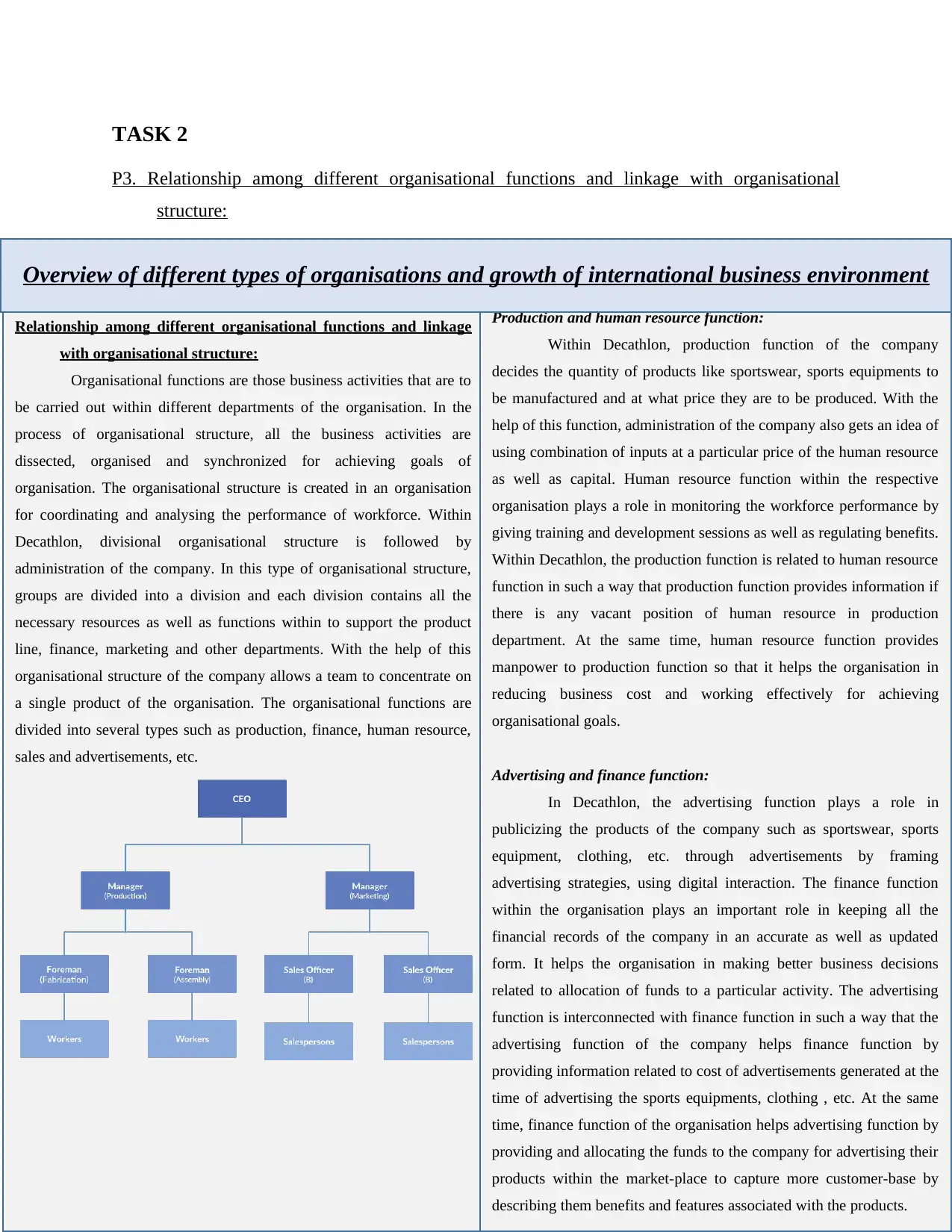
TASK 2
P3. Relationship among different organisational functions and linkage with organisational
structure:
Relationship among different organisational functions and linkage
with organisational structure:
Organisational functions are those business activities that are to
be carried out within different departments of the organisation. In the
process of organisational structure, all the business activities are
dissected, organised and synchronized for achieving goals of
organisation. The organisational structure is created in an organisation
for coordinating and analysing the performance of workforce. Within
Decathlon, divisional organisational structure is followed by
administration of the company. In this type of organisational structure,
groups are divided into a division and each division contains all the
necessary resources as well as functions within to support the product
line, finance, marketing and other departments. With the help of this
organisational structure of the company allows a team to concentrate on
a single product of the organisation. The organisational functions are
divided into several types such as production, finance, human resource,
sales and advertisements, etc.
Production and human resource function:
Within Decathlon, production function of the company
decides the quantity of products like sportswear, sports equipments to
be manufactured and at what price they are to be produced. With the
help of this function, administration of the company also gets an idea of
using combination of inputs at a particular price of the human resource
as well as capital. Human resource function within the respective
organisation plays a role in monitoring the workforce performance by
giving training and development sessions as well as regulating benefits.
Within Decathlon, the production function is related to human resource
function in such a way that production function provides information if
there is any vacant position of human resource in production
department. At the same time, human resource function provides
manpower to production function so that it helps the organisation in
reducing business cost and working effectively for achieving
organisational goals.
Advertising and finance function:
In Decathlon, the advertising function plays a role in
publicizing the products of the company such as sportswear, sports
equipment, clothing, etc. through advertisements by framing
advertising strategies, using digital interaction. The finance function
within the organisation plays an important role in keeping all the
financial records of the company in an accurate as well as updated
form. It helps the organisation in making better business decisions
related to allocation of funds to a particular activity. The advertising
function is interconnected with finance function in such a way that the
advertising function of the company helps finance function by
providing information related to cost of advertisements generated at the
time of advertising the sports equipments, clothing , etc. At the same
time, finance function of the organisation helps advertising function by
providing and allocating the funds to the company for advertising their
products within the market-place to capture more customer-base by
describing them benefits and features associated with the products.
Overview of different types of organisations and growth of international business environment
P3. Relationship among different organisational functions and linkage with organisational
structure:
Relationship among different organisational functions and linkage
with organisational structure:
Organisational functions are those business activities that are to
be carried out within different departments of the organisation. In the
process of organisational structure, all the business activities are
dissected, organised and synchronized for achieving goals of
organisation. The organisational structure is created in an organisation
for coordinating and analysing the performance of workforce. Within
Decathlon, divisional organisational structure is followed by
administration of the company. In this type of organisational structure,
groups are divided into a division and each division contains all the
necessary resources as well as functions within to support the product
line, finance, marketing and other departments. With the help of this
organisational structure of the company allows a team to concentrate on
a single product of the organisation. The organisational functions are
divided into several types such as production, finance, human resource,
sales and advertisements, etc.
Production and human resource function:
Within Decathlon, production function of the company
decides the quantity of products like sportswear, sports equipments to
be manufactured and at what price they are to be produced. With the
help of this function, administration of the company also gets an idea of
using combination of inputs at a particular price of the human resource
as well as capital. Human resource function within the respective
organisation plays a role in monitoring the workforce performance by
giving training and development sessions as well as regulating benefits.
Within Decathlon, the production function is related to human resource
function in such a way that production function provides information if
there is any vacant position of human resource in production
department. At the same time, human resource function provides
manpower to production function so that it helps the organisation in
reducing business cost and working effectively for achieving
organisational goals.
Advertising and finance function:
In Decathlon, the advertising function plays a role in
publicizing the products of the company such as sportswear, sports
equipment, clothing, etc. through advertisements by framing
advertising strategies, using digital interaction. The finance function
within the organisation plays an important role in keeping all the
financial records of the company in an accurate as well as updated
form. It helps the organisation in making better business decisions
related to allocation of funds to a particular activity. The advertising
function is interconnected with finance function in such a way that the
advertising function of the company helps finance function by
providing information related to cost of advertisements generated at the
time of advertising the sports equipments, clothing , etc. At the same
time, finance function of the organisation helps advertising function by
providing and allocating the funds to the company for advertising their
products within the market-place to capture more customer-base by
describing them benefits and features associated with the products.
Overview of different types of organisations and growth of international business environment
⊘ This is a preview!⊘
Do you want full access?
Subscribe today to unlock all pages.

Trusted by 1+ million students worldwide
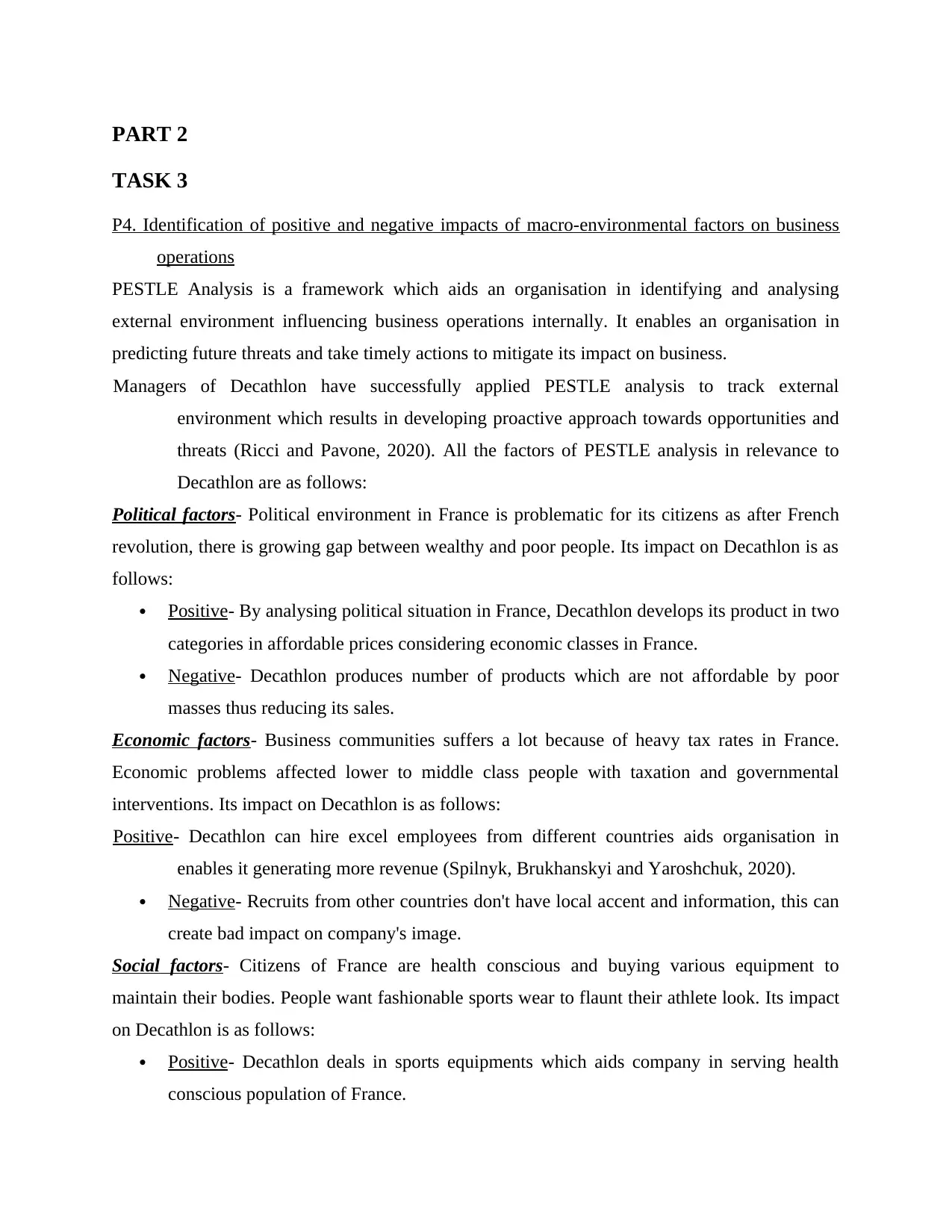
PART 2
TASK 3
P4. Identification of positive and negative impacts of macro-environmental factors on business
operations
PESTLE Analysis is a framework which aids an organisation in identifying and analysing
external environment influencing business operations internally. It enables an organisation in
predicting future threats and take timely actions to mitigate its impact on business.
Managers of Decathlon have successfully applied PESTLE analysis to track external
environment which results in developing proactive approach towards opportunities and
threats (Ricci and Pavone, 2020). All the factors of PESTLE analysis in relevance to
Decathlon are as follows:
Political factors- Political environment in France is problematic for its citizens as after French
revolution, there is growing gap between wealthy and poor people. Its impact on Decathlon is as
follows:
Positive- By analysing political situation in France, Decathlon develops its product in two
categories in affordable prices considering economic classes in France.
Negative- Decathlon produces number of products which are not affordable by poor
masses thus reducing its sales.
Economic factors- Business communities suffers a lot because of heavy tax rates in France.
Economic problems affected lower to middle class people with taxation and governmental
interventions. Its impact on Decathlon is as follows:
Positive- Decathlon can hire excel employees from different countries aids organisation in
enables it generating more revenue (Spilnyk, Brukhanskyi and Yaroshchuk, 2020).
Negative- Recruits from other countries don't have local accent and information, this can
create bad impact on company's image.
Social factors- Citizens of France are health conscious and buying various equipment to
maintain their bodies. People want fashionable sports wear to flaunt their athlete look. Its impact
on Decathlon is as follows:
Positive- Decathlon deals in sports equipments which aids company in serving health
conscious population of France.
TASK 3
P4. Identification of positive and negative impacts of macro-environmental factors on business
operations
PESTLE Analysis is a framework which aids an organisation in identifying and analysing
external environment influencing business operations internally. It enables an organisation in
predicting future threats and take timely actions to mitigate its impact on business.
Managers of Decathlon have successfully applied PESTLE analysis to track external
environment which results in developing proactive approach towards opportunities and
threats (Ricci and Pavone, 2020). All the factors of PESTLE analysis in relevance to
Decathlon are as follows:
Political factors- Political environment in France is problematic for its citizens as after French
revolution, there is growing gap between wealthy and poor people. Its impact on Decathlon is as
follows:
Positive- By analysing political situation in France, Decathlon develops its product in two
categories in affordable prices considering economic classes in France.
Negative- Decathlon produces number of products which are not affordable by poor
masses thus reducing its sales.
Economic factors- Business communities suffers a lot because of heavy tax rates in France.
Economic problems affected lower to middle class people with taxation and governmental
interventions. Its impact on Decathlon is as follows:
Positive- Decathlon can hire excel employees from different countries aids organisation in
enables it generating more revenue (Spilnyk, Brukhanskyi and Yaroshchuk, 2020).
Negative- Recruits from other countries don't have local accent and information, this can
create bad impact on company's image.
Social factors- Citizens of France are health conscious and buying various equipment to
maintain their bodies. People want fashionable sports wear to flaunt their athlete look. Its impact
on Decathlon is as follows:
Positive- Decathlon deals in sports equipments which aids company in serving health
conscious population of France.
Paraphrase This Document
Need a fresh take? Get an instant paraphrase of this document with our AI Paraphraser
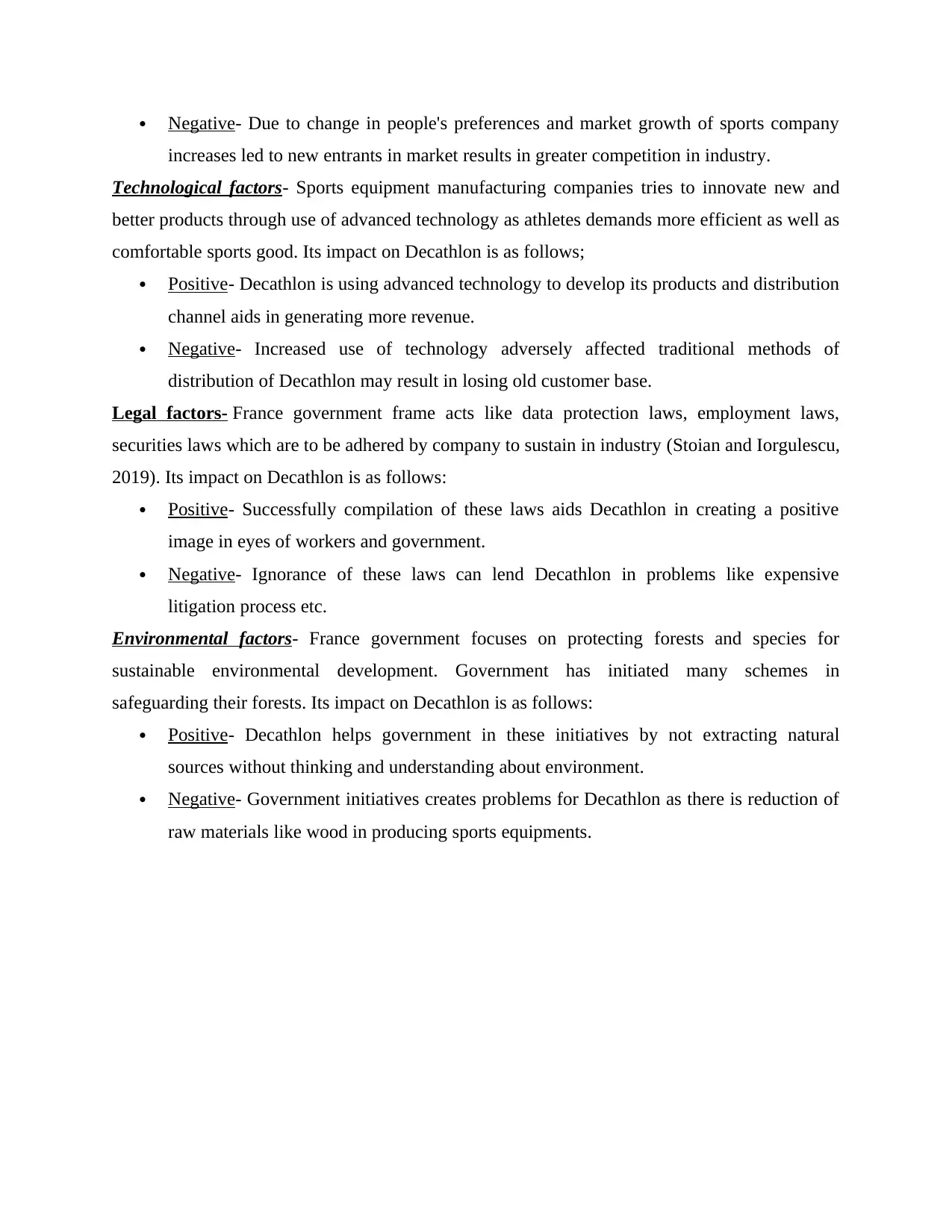
Negative- Due to change in people's preferences and market growth of sports company
increases led to new entrants in market results in greater competition in industry.
Technological factors- Sports equipment manufacturing companies tries to innovate new and
better products through use of advanced technology as athletes demands more efficient as well as
comfortable sports good. Its impact on Decathlon is as follows;
Positive- Decathlon is using advanced technology to develop its products and distribution
channel aids in generating more revenue.
Negative- Increased use of technology adversely affected traditional methods of
distribution of Decathlon may result in losing old customer base.
Legal factors- France government frame acts like data protection laws, employment laws,
securities laws which are to be adhered by company to sustain in industry (Stoian and Iorgulescu,
2019). Its impact on Decathlon is as follows:
Positive- Successfully compilation of these laws aids Decathlon in creating a positive
image in eyes of workers and government.
Negative- Ignorance of these laws can lend Decathlon in problems like expensive
litigation process etc.
Environmental factors- France government focuses on protecting forests and species for
sustainable environmental development. Government has initiated many schemes in
safeguarding their forests. Its impact on Decathlon is as follows:
Positive- Decathlon helps government in these initiatives by not extracting natural
sources without thinking and understanding about environment.
Negative- Government initiatives creates problems for Decathlon as there is reduction of
raw materials like wood in producing sports equipments.
increases led to new entrants in market results in greater competition in industry.
Technological factors- Sports equipment manufacturing companies tries to innovate new and
better products through use of advanced technology as athletes demands more efficient as well as
comfortable sports good. Its impact on Decathlon is as follows;
Positive- Decathlon is using advanced technology to develop its products and distribution
channel aids in generating more revenue.
Negative- Increased use of technology adversely affected traditional methods of
distribution of Decathlon may result in losing old customer base.
Legal factors- France government frame acts like data protection laws, employment laws,
securities laws which are to be adhered by company to sustain in industry (Stoian and Iorgulescu,
2019). Its impact on Decathlon is as follows:
Positive- Successfully compilation of these laws aids Decathlon in creating a positive
image in eyes of workers and government.
Negative- Ignorance of these laws can lend Decathlon in problems like expensive
litigation process etc.
Environmental factors- France government focuses on protecting forests and species for
sustainable environmental development. Government has initiated many schemes in
safeguarding their forests. Its impact on Decathlon is as follows:
Positive- Decathlon helps government in these initiatives by not extracting natural
sources without thinking and understanding about environment.
Negative- Government initiatives creates problems for Decathlon as there is reduction of
raw materials like wood in producing sports equipments.
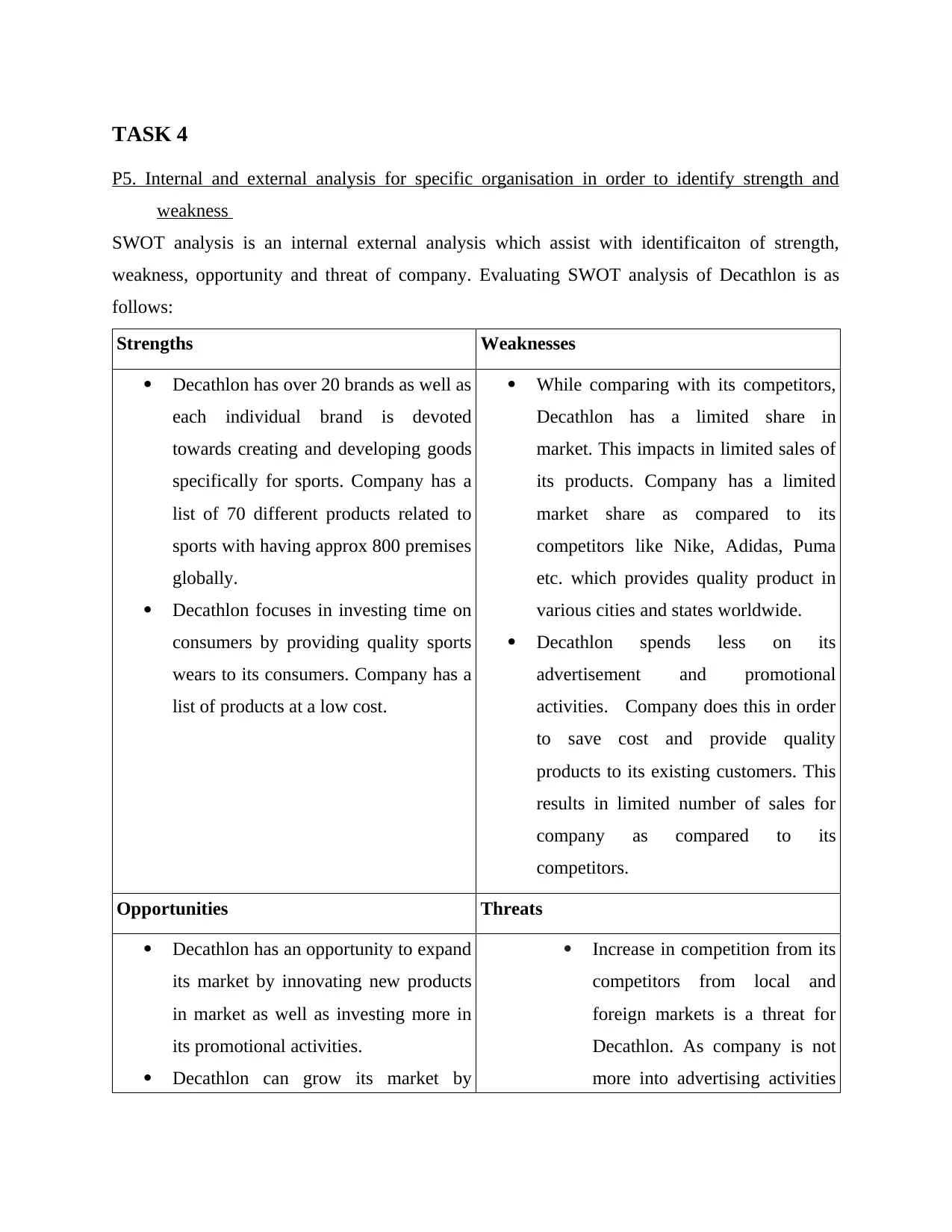
TASK 4
P5. Internal and external analysis for specific organisation in order to identify strength and
weakness
SWOT analysis is an internal external analysis which assist with identificaiton of strength,
weakness, opportunity and threat of company. Evaluating SWOT analysis of Decathlon is as
follows:
Strengths Weaknesses
Decathlon has over 20 brands as well as
each individual brand is devoted
towards creating and developing goods
specifically for sports. Company has a
list of 70 different products related to
sports with having approx 800 premises
globally.
Decathlon focuses in investing time on
consumers by providing quality sports
wears to its consumers. Company has a
list of products at a low cost.
While comparing with its competitors,
Decathlon has a limited share in
market. This impacts in limited sales of
its products. Company has a limited
market share as compared to its
competitors like Nike, Adidas, Puma
etc. which provides quality product in
various cities and states worldwide.
Decathlon spends less on its
advertisement and promotional
activities. Company does this in order
to save cost and provide quality
products to its existing customers. This
results in limited number of sales for
company as compared to its
competitors.
Opportunities Threats
Decathlon has an opportunity to expand
its market by innovating new products
in market as well as investing more in
its promotional activities.
Decathlon can grow its market by
Increase in competition from its
competitors from local and
foreign markets is a threat for
Decathlon. As company is not
more into advertising activities
P5. Internal and external analysis for specific organisation in order to identify strength and
weakness
SWOT analysis is an internal external analysis which assist with identificaiton of strength,
weakness, opportunity and threat of company. Evaluating SWOT analysis of Decathlon is as
follows:
Strengths Weaknesses
Decathlon has over 20 brands as well as
each individual brand is devoted
towards creating and developing goods
specifically for sports. Company has a
list of 70 different products related to
sports with having approx 800 premises
globally.
Decathlon focuses in investing time on
consumers by providing quality sports
wears to its consumers. Company has a
list of products at a low cost.
While comparing with its competitors,
Decathlon has a limited share in
market. This impacts in limited sales of
its products. Company has a limited
market share as compared to its
competitors like Nike, Adidas, Puma
etc. which provides quality product in
various cities and states worldwide.
Decathlon spends less on its
advertisement and promotional
activities. Company does this in order
to save cost and provide quality
products to its existing customers. This
results in limited number of sales for
company as compared to its
competitors.
Opportunities Threats
Decathlon has an opportunity to expand
its market by innovating new products
in market as well as investing more in
its promotional activities.
Decathlon can grow its market by
Increase in competition from its
competitors from local and
foreign markets is a threat for
Decathlon. As company is not
more into advertising activities
⊘ This is a preview!⊘
Do you want full access?
Subscribe today to unlock all pages.

Trusted by 1+ million students worldwide
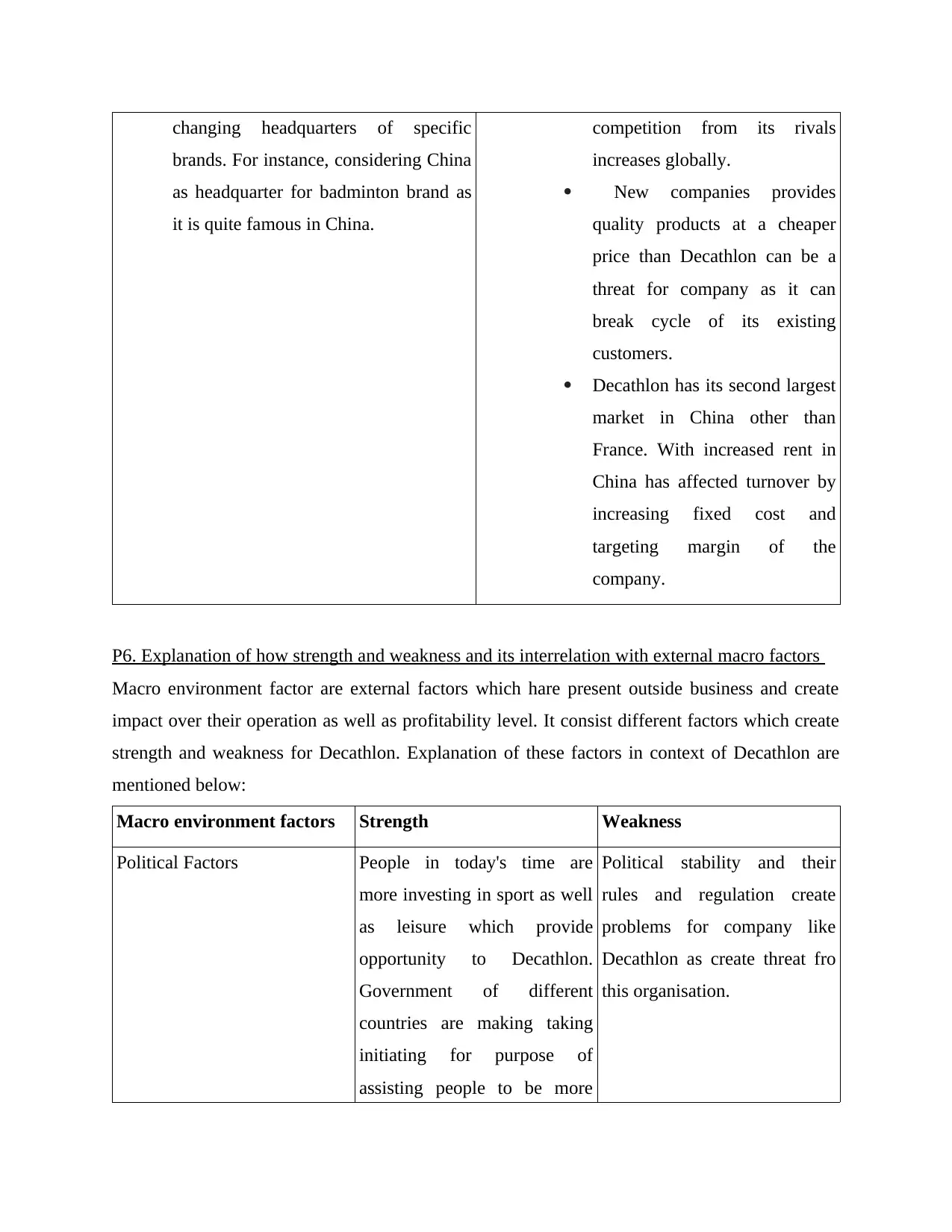
changing headquarters of specific
brands. For instance, considering China
as headquarter for badminton brand as
it is quite famous in China.
competition from its rivals
increases globally.
New companies provides
quality products at a cheaper
price than Decathlon can be a
threat for company as it can
break cycle of its existing
customers.
Decathlon has its second largest
market in China other than
France. With increased rent in
China has affected turnover by
increasing fixed cost and
targeting margin of the
company.
P6. Explanation of how strength and weakness and its interrelation with external macro factors
Macro environment factor are external factors which hare present outside business and create
impact over their operation as well as profitability level. It consist different factors which create
strength and weakness for Decathlon. Explanation of these factors in context of Decathlon are
mentioned below:
Macro environment factors Strength Weakness
Political Factors People in today's time are
more investing in sport as well
as leisure which provide
opportunity to Decathlon.
Government of different
countries are making taking
initiating for purpose of
assisting people to be more
Political stability and their
rules and regulation create
problems for company like
Decathlon as create threat fro
this organisation.
brands. For instance, considering China
as headquarter for badminton brand as
it is quite famous in China.
competition from its rivals
increases globally.
New companies provides
quality products at a cheaper
price than Decathlon can be a
threat for company as it can
break cycle of its existing
customers.
Decathlon has its second largest
market in China other than
France. With increased rent in
China has affected turnover by
increasing fixed cost and
targeting margin of the
company.
P6. Explanation of how strength and weakness and its interrelation with external macro factors
Macro environment factor are external factors which hare present outside business and create
impact over their operation as well as profitability level. It consist different factors which create
strength and weakness for Decathlon. Explanation of these factors in context of Decathlon are
mentioned below:
Macro environment factors Strength Weakness
Political Factors People in today's time are
more investing in sport as well
as leisure which provide
opportunity to Decathlon.
Government of different
countries are making taking
initiating for purpose of
assisting people to be more
Political stability and their
rules and regulation create
problems for company like
Decathlon as create threat fro
this organisation.
Paraphrase This Document
Need a fresh take? Get an instant paraphrase of this document with our AI Paraphraser
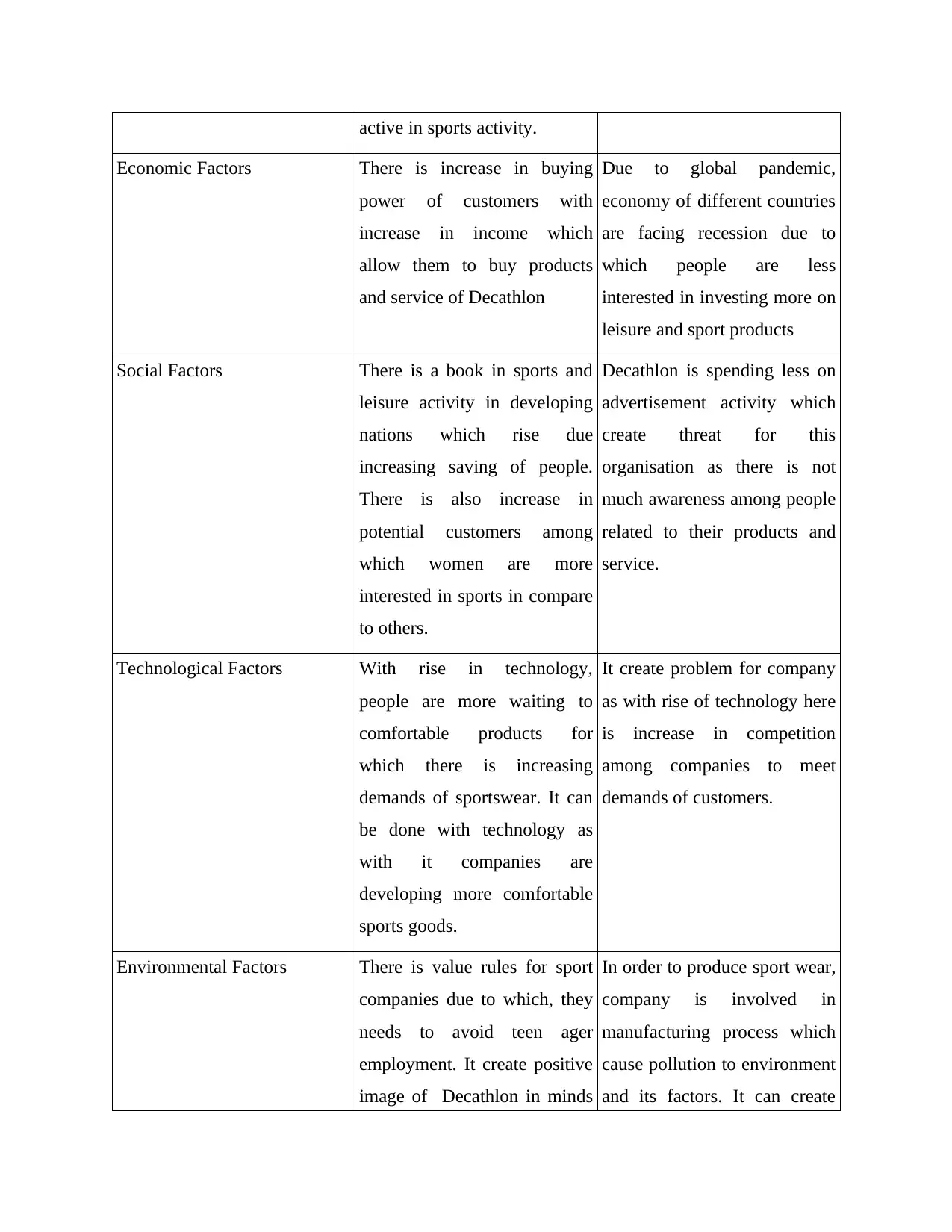
active in sports activity.
Economic Factors There is increase in buying
power of customers with
increase in income which
allow them to buy products
and service of Decathlon
Due to global pandemic,
economy of different countries
are facing recession due to
which people are less
interested in investing more on
leisure and sport products
Social Factors There is a book in sports and
leisure activity in developing
nations which rise due
increasing saving of people.
There is also increase in
potential customers among
which women are more
interested in sports in compare
to others.
Decathlon is spending less on
advertisement activity which
create threat for this
organisation as there is not
much awareness among people
related to their products and
service.
Technological Factors With rise in technology,
people are more waiting to
comfortable products for
which there is increasing
demands of sportswear. It can
be done with technology as
with it companies are
developing more comfortable
sports goods.
It create problem for company
as with rise of technology here
is increase in competition
among companies to meet
demands of customers.
Environmental Factors There is value rules for sport
companies due to which, they
needs to avoid teen ager
employment. It create positive
image of Decathlon in minds
In order to produce sport wear,
company is involved in
manufacturing process which
cause pollution to environment
and its factors. It can create
Economic Factors There is increase in buying
power of customers with
increase in income which
allow them to buy products
and service of Decathlon
Due to global pandemic,
economy of different countries
are facing recession due to
which people are less
interested in investing more on
leisure and sport products
Social Factors There is a book in sports and
leisure activity in developing
nations which rise due
increasing saving of people.
There is also increase in
potential customers among
which women are more
interested in sports in compare
to others.
Decathlon is spending less on
advertisement activity which
create threat for this
organisation as there is not
much awareness among people
related to their products and
service.
Technological Factors With rise in technology,
people are more waiting to
comfortable products for
which there is increasing
demands of sportswear. It can
be done with technology as
with it companies are
developing more comfortable
sports goods.
It create problem for company
as with rise of technology here
is increase in competition
among companies to meet
demands of customers.
Environmental Factors There is value rules for sport
companies due to which, they
needs to avoid teen ager
employment. It create positive
image of Decathlon in minds
In order to produce sport wear,
company is involved in
manufacturing process which
cause pollution to environment
and its factors. It can create
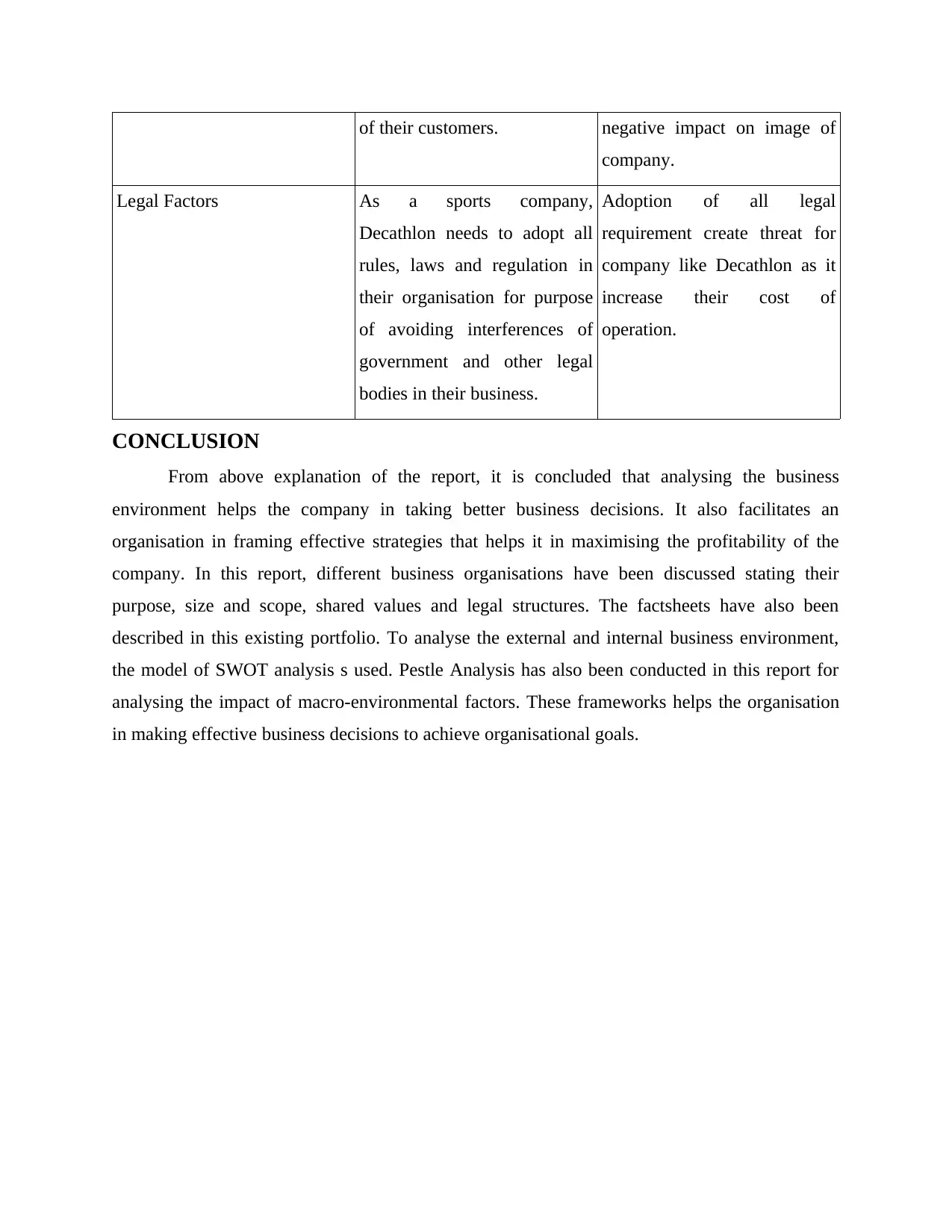
of their customers. negative impact on image of
company.
Legal Factors As a sports company,
Decathlon needs to adopt all
rules, laws and regulation in
their organisation for purpose
of avoiding interferences of
government and other legal
bodies in their business.
Adoption of all legal
requirement create threat for
company like Decathlon as it
increase their cost of
operation.
CONCLUSION
From above explanation of the report, it is concluded that analysing the business
environment helps the company in taking better business decisions. It also facilitates an
organisation in framing effective strategies that helps it in maximising the profitability of the
company. In this report, different business organisations have been discussed stating their
purpose, size and scope, shared values and legal structures. The factsheets have also been
described in this existing portfolio. To analyse the external and internal business environment,
the model of SWOT analysis s used. Pestle Analysis has also been conducted in this report for
analysing the impact of macro-environmental factors. These frameworks helps the organisation
in making effective business decisions to achieve organisational goals.
company.
Legal Factors As a sports company,
Decathlon needs to adopt all
rules, laws and regulation in
their organisation for purpose
of avoiding interferences of
government and other legal
bodies in their business.
Adoption of all legal
requirement create threat for
company like Decathlon as it
increase their cost of
operation.
CONCLUSION
From above explanation of the report, it is concluded that analysing the business
environment helps the company in taking better business decisions. It also facilitates an
organisation in framing effective strategies that helps it in maximising the profitability of the
company. In this report, different business organisations have been discussed stating their
purpose, size and scope, shared values and legal structures. The factsheets have also been
described in this existing portfolio. To analyse the external and internal business environment,
the model of SWOT analysis s used. Pestle Analysis has also been conducted in this report for
analysing the impact of macro-environmental factors. These frameworks helps the organisation
in making effective business decisions to achieve organisational goals.
⊘ This is a preview!⊘
Do you want full access?
Subscribe today to unlock all pages.

Trusted by 1+ million students worldwide
1 out of 14
Related Documents
Your All-in-One AI-Powered Toolkit for Academic Success.
+13062052269
info@desklib.com
Available 24*7 on WhatsApp / Email
![[object Object]](/_next/static/media/star-bottom.7253800d.svg)
Unlock your academic potential
Copyright © 2020–2025 A2Z Services. All Rights Reserved. Developed and managed by ZUCOL.



